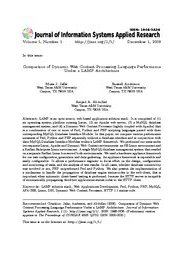Volume 1
Abstract: LAMP is an open source, web-based application solution stack. It is comprised of (1) an operating system platform running Linux, (2) an Apache web server, (3) a MySQL database management system, and (4) a Dynamic Web Content Processor (tightly coupled with Apache) that is a combination of one or more of Perl, Python and PHP scripting languages paired with their corresponding MySQL Database Interface Module. In this paper, we compare various performance measures of Perl, Python and PHP separately without a database interface and in conjunction with their MySQL Database Interface Modules within a LAMP framework. We performed our tests under two separate Linux, Apache and Dynamic Web Content environments: an SE Linux environment and a Redhat Enterprise Linux environment. A single MySQL database management system that resided on a separate Redhat Linux box served both environments. We used a hardware appliance framework for our test configuration, generation and data gathering. An appliance framework is repeatable and easily configurable. It allows a performance engineer to focus effort on the design, configuration and monitoring of tests, and the analysis of test results. In all cases, whether database connectivity was involved or not, PHP outperformed Perl and Python. We also present the implementation of a mechanism to handle the propagation of database engine status-codes to the web-client, this is important when automatic client-based testing is performed, because the HTTP server is incapable of automatically propagating third-tier applications status-codes to the HTTP client. Recommended Citation: Jafar, Anderson, and Abdullat (2008). Comparison of Dynamic Web Content Processing Language Performance Under a LAMP Architecture. Journal of Information Systems Applied Research, 1 (1). http://jisar.org/1/1/. ISSN: 1946-1836. (A preliminary version appears in The Proceedings of CONISAR 2008: §2732) . |
